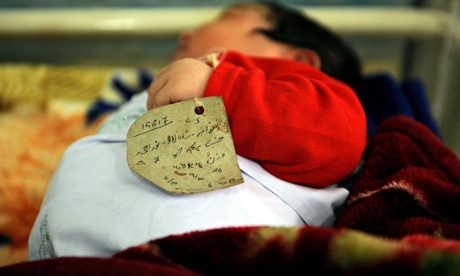
More than six million children under five died last year, mostly from preventable causes and almost half in the first month of life, according to the latest UN estimates.
Pneumonia, diarrhoea and malaria were among the leading causes of death, while undernutrition contributed to almost half of all under-five deaths. Complications before and during child birth were also significant.
However, the pace of change has accelerated over recent years, according to the Levels and trends in child mortality 2014 report, published on Tuesday by a group led by the UN children’s agency Unicef and including the World Health Organisation (WHO) and World Bank.
Last year, 200,000 fewer children died than in 2012, which means the global under-five mortality rate dropped by almost half between 1990 and 2013 – to 6.3 million last year from 12.7 million in 1990.
But the figures are still way off the target of a two-thirds decrease by 2015, outlined in the millennium development goals (MDGs).
The estimates show that 44% of under-five deaths last year were within the first month of life. About two-thirds of these deaths occurred in only 10 countries. The report found that while the number of neonatal deaths has declined, progress has been slower than for the overall under-five mortality rate.
In June, Unicef and the WHO launched a plan to end preventable newborn deaths and stillbirths by 2035. The plan calls for all countries to provide basic health services, particularly around the time of childbirth, and to improve the quality of care.
The latest estimates said policies to protect newborn babies need to be closely linked to better maternal health. Global targets to reduce maternal mortality are also unlikely to meet the MDG deadline. According to a report in the Lancet in May, only 16 countries are expected to reduce by three-quarters the number of maternal deaths, and achieve universal access to family planning next year.
“With 2.8 million newborns dying each year, accounting for 44% of under-five deaths, progress has been insufficient and is now impeding improvement in child survival worldwide,” said the report. “Neonatal health will need to be addressed more effectively for progress on overall child mortality to continue rapidly. Further reductions in neonatal deaths in particular depend on building stronger health services, ensuring that every birth is attended by skilled personnel and making hospital care available in an emergency.”
Olusoji Adeyi, director of health, nutrition and population at the World Bank, said: “For continued progress, it is essential to invest more in health systems that deliver high-quality, affordable services to all women and children who need them.”
About half of all under-five deaths occur in India, Nigeria, Pakistan, the Democratic Republic of the Congo and China, with India (21%) and Nigeria (13%) accounting for more than a third.
Sub-Saharan Africa has cut under-five deaths by 48% since 1990, but it still has the world’s highest rate – 92 deaths per 1,000 live births; almost 15 times the average rate in high-income countries.
Liberia, Bangladesh, Ethiopia and Niger have already reached or surpassed the MDG target. Regionally, east Asia, Latin America and the Caribbean, and north Africa have reduced mortality rates by more than two-thirds since 1990.
“There has been dramatic and accelerating progress in reducing mortality among children, and the data prove that success is possible even for poorly resourced countries,” said Mickey Chopra, head of Unicef’s global health programmes. “There is now a gathering momentum from countries in every part of the world to make sure proven, cost-effective interventions are applied where they will save the most lives.”
A separate study looking at the impact of initiatives to combat child deaths in 142 countries found that while half of the reduction could be attributed to early immunisation and the attendance of a skilled health worker at birth, other factors outside the health arena played a significant part. These included improved access to education for girls, women’s participation in politics and the workforce, access to clean water and sanitation, and access to family planning.
The research, Success factors for women’s and children’s health, published on Tuesday by the Partnership for Maternal, Newborn and Child Health, identified 10 low- and middle-income countries that have been highly successful in reducing child mortality by addressing health and other factors.
In Rwanda, where 64% of parliamentarians are women and the government has focused on education, clean water provision and a health insurance scheme, child deaths fell from 152 per 1,000 live births in 1990 to 52 in 2013.

